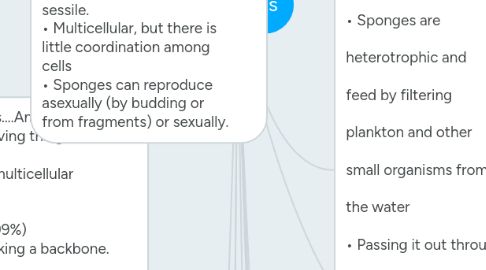Sponges
by Taylor Williams

1. Two Types of Zoo Plankton Temporary Plankton (These are animals) – Embryos or larvae of marine organisms: • Fish, crabs, sponges, lobster, clams, and other invertebrates – Spend early part of their life cycle floating and drifting near the surface of the ocean • When they mature, they settle to the bottom, where they develop into adults • Permanent Plankton – Remain in the plankton population throughout their entire life cycle – The copepod is the most numerous and • Tiny shrimp-like animal that feeds on diatoms • In turn, it’s food for other larger zooplankton, small fish and whales • Copepods are an important link in many marine food chains
2. Exploring Animals….Animals are the most diverse of living things • All animals are multicellular heterotorphs • Almost all are (99%) invertebrates, lacking a backbone. • No Cell Walls • Cells of all animals, except sponges, are organized into structural and functional units called tissue. • Active Movement, due to flexibility of cells, and evolution of nerve and muscle tissues. • Sexual Reproduction • Embryonic Development
3. Parazoa: Sponges 1. Sponges, Phylum Porifera, are multicellular heterotrophs. 2. Asymmetrical, lacks a definite symmetry 3. NO tissue or organs 4. phylum Porifera, sponges• phylum Porifera, there are around 5000 species, 150 are freshwater • Abundant at all depths in the sea • Adults are anchored to a submerged object, called sessile. • Multicellular, but there is little coordination among cells • Sponges can reproduce asexually (by budding or from fragments) or sexually.
4. Suspension Feeders • The sponges have specialized, flagellated cells called choanocytes • These cells move their flagella to draw in water in through pores bringing in food and oxygen and expelling wastes.
5. Suspension Feeders • Choanocytes take in small particles by phagocytosis. – Protein molecules are taken in by pinocytosis. • Sponges can also absorb nutrients dissolved in the water.
6. Types of Cells • Choanocytes, flagellated collar cells, generate a water current through the sponge and ingest suspended food. Suspension Feeders • Choanocytes take in small particles by phagocytosis. – Protein molecules are taken in by pinocytosis. • Sponges can also absorb nutrients dissolved in the water. Choanoflagellates • Choanoflagellates are solitary or colonial protozoans with a flagellum surrounded by a collar of microvilli.
7. Protozoan: An amazing group of animal-like protists: Carry out all necessary life functions within a single cell • Ingestion and digestion – Can capture food – Ingest food through an oral grove (“mouth”) – Food vacuoles take care of intercellular digestion • Example - With a ring of cilia around mouth
8. Zoo Plankton and the Sea Zooplankton are Animal-like organisms that float and drift on the ocean surface – Plankton means “wanderers” • Vary in size – from jellyfish to microorganisms – Most are microorganisms • Foundation of the marine food web – Important source of food for many other organisms • “Spring Blooms” – an increase in zooplankton population – Due to increase in phytoplankton – food for zooplankton
9. Animal: Multicellular organism • Consumes food • Able to move
10. Simple Animals – No Body Cavity • We will start with the simplest of the animal kingdom • sponges, jellyfish, and simple worms • These animals lack a body cavity called a coelom, and are thus called acoelomates
11. Phylum Porifera • Sponges range in size and shape. – Up to 2 meters in diameter! – Encrusting, boring, finger, tube or vase shaped.
12. Neighbors • Many organisms, including crabs, nudibranchs, mites, bryozoans, and fish live as commensals or parasites in sponges.
13. Suspension Feeders • Sponges are heterotrophic and feed by filtering plankton and other small organisms from the water • Passing it out through the large opening (osculum) at one end of the body.
14. Suspension Feeders • Sponges are suspension feeders capturing food particles suspended in the water that passes through their body.
15. Skeletal Framework • The skeletal framework of a sponge may be fibrous or • The fibrous part comes from collagen fibrils in the intercellular matrix. – Spongin • Rigid skeletons consist of needlelike spicules. – Calcareous – Siliceous • Composition and shape the spicules forms the basis of sponge classification.


